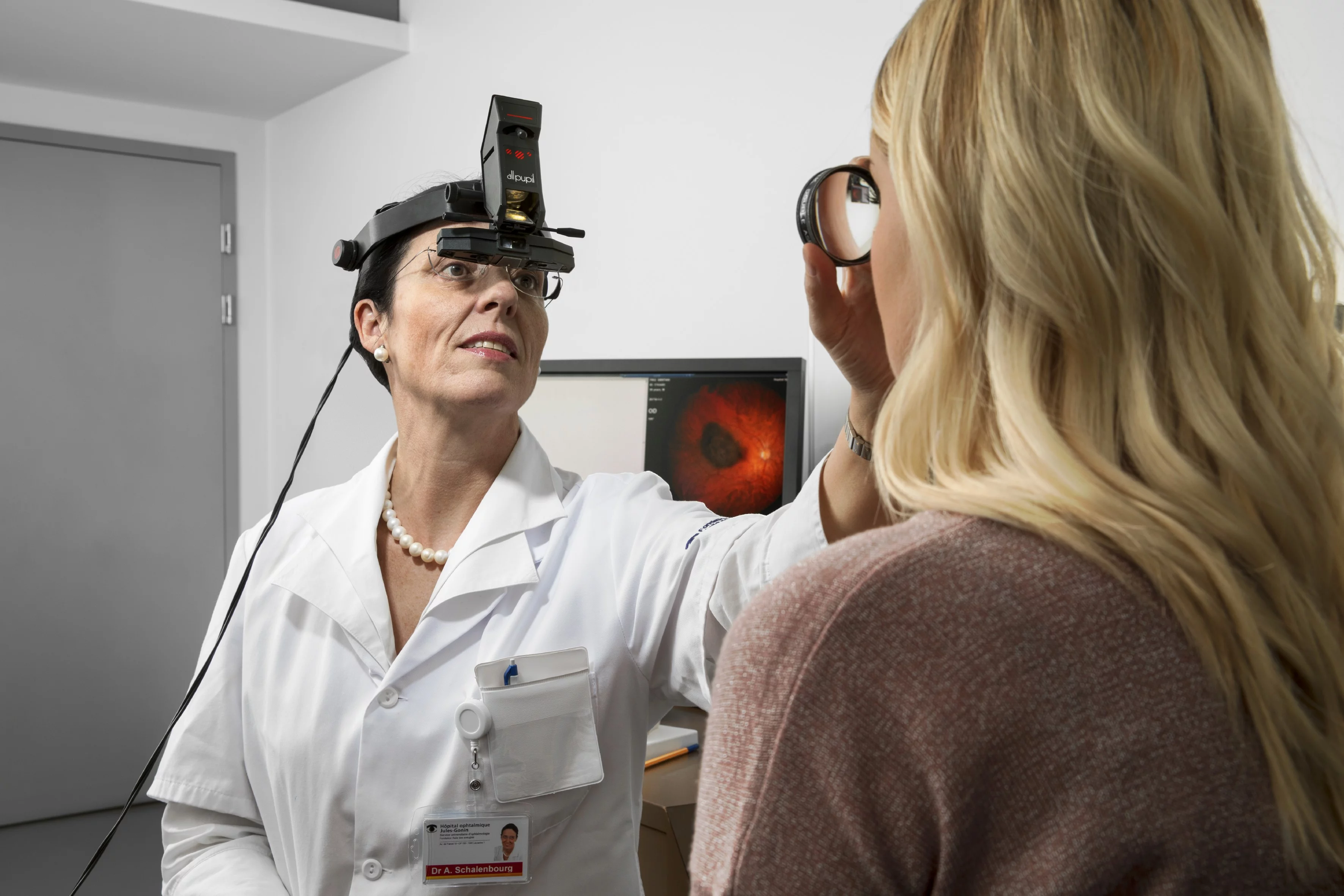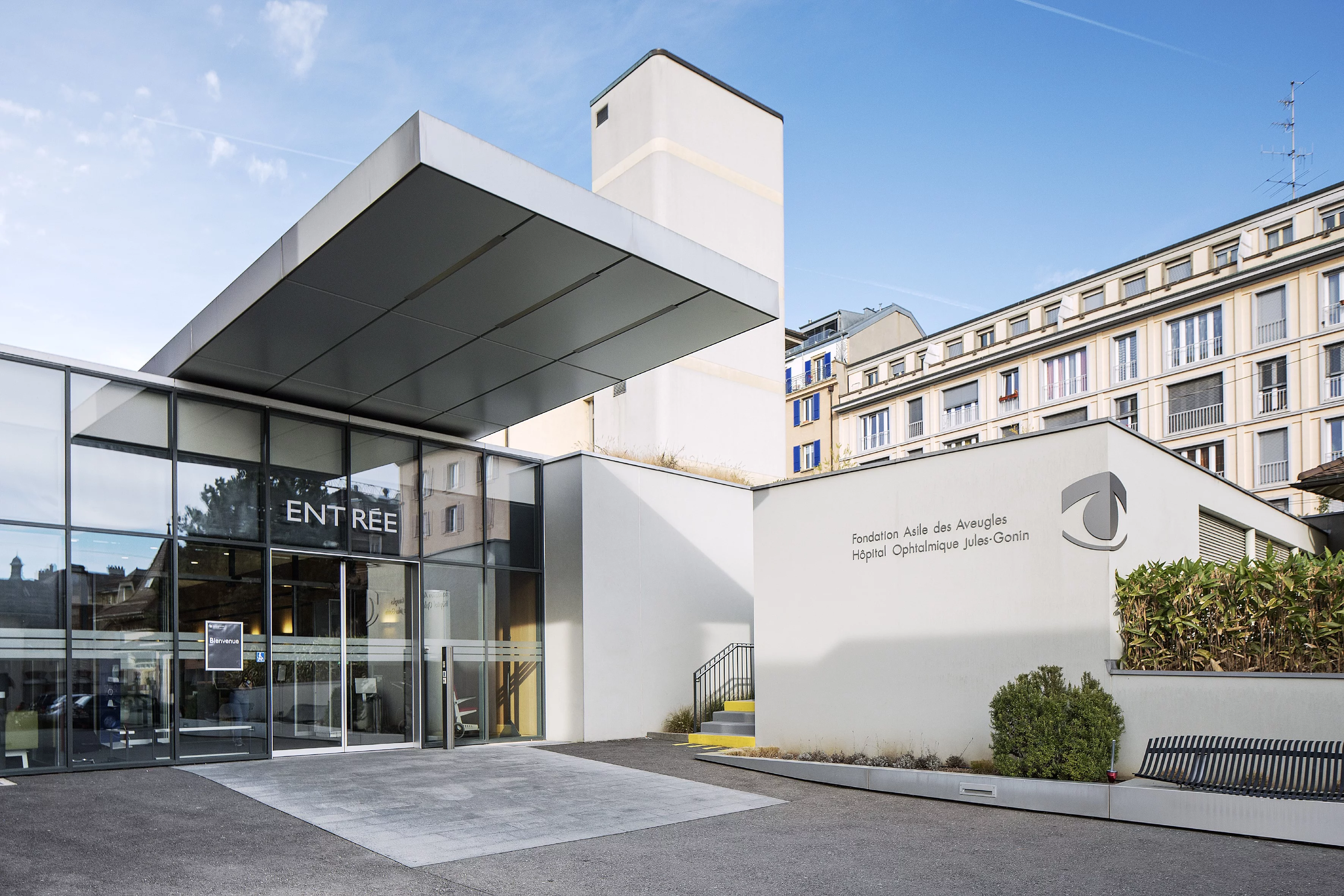Nowhere in the world have so many ocular tumours been irradiated with protons as at the Paul Scherrer Institute PSI. But before the affected patients go to Villigen, they have to visit Lausanne: for pretreatment at the Jules Gonin Ophthalmic Hospital. The more than 30-year-long collaboration between the hospital and PSI is unique, and in most cases it saves the patient's diseased eye.
There are places in Switzerland where time passes more quickly and the pace of everyday life seems faster. One of those places is around Ann Schalenbourg. When the tall, energetic woman rushes into her medical office, she sparkles with energy, and her white coat flutters over the black deux-pièces. Dr. Ann Schalenbourg is head of the ocular oncology department for adults at the Jules Gonin Ophthalmic Hospital in Lausanne. Schalenbourg has worked here for 23 years, and if anyone had predicted this at the beginning of her career, the native Belgian would have just laughed: Really, I mainly wanted to treat cataracts.
Then, however, she followed her husband to Lausanne, and everything turned out differently. At the time, the only job available to the young doctor was in ocular oncology. Patients go there with black melanoma in the eye or twisted blood vessels on the ocular fundus. I never thought that I would dedicate almost my entire professional life to the treatment of ocular tumours
, Schalenbourg says today. But it makes me feel thankful and happy, because I can offer my patients the best treatment there is.
First use in Europe
The best treatment – by that the doctor means proton irradiation at PSI in Villigen. There, this irradiation technique has been in use since the 1980s. Back then, physicists at an institute that was a forerunner of PSI, together with the Lausanne-based ophthalmologist Leonidas Zografos, perfected a method that would come to save thousands of patients' eyes: They were the first in Europe to irradiate malignant tumours on the ocular fundus with protons.
Protons hit their target with millimetre accuracy during irradiation. That makes them the ideal tool for use on the eye, because every over-irradiated millimetre means a bit of vision loss. Still, Zografos and his one-time student Schalenbourg know how to avoid that. In a surgical operation, they suture tiny metal clips onto the back side of the eyeball. These serve as markers for the specialists at PSI, by which they can locate the tumour and irradiate it dead on target. The collaboration between PSI and the Jules Gonin Ophthalmic Hospital is very close
, says Alessia Pica, radiologist at the Center for Proton Therapy at PSI. Before a patient comes to us for irradiation, they are examined and operated on in Lausanne.
To date, there have already been 6,700 patients.
Tight schedule
Every Tuesday is surgery day for Ann Schalenbourg. This time too, as a 40-year-old patient is already sleeping under anaesthesia. The doctor slips into her blue surgical scrubs, pulls on the sterile gloves, and gets started with the precision work. She makes a tiny incision in the conjunctiva of the eye and carefully pushes the delicate surgical instruments past the ocular muscles and behind the eye. Then the lights in the operating room are turned out. In the darkness, she shines a light directly through the eye from front to back. The light reaches all the way to the ocular fundus and is clearly visible on the back side of the eyeball
, the doctor explains. But where a tumour is located, no light comes through, and I see only a shadow.
Around these shadows Schalenbourg sews on the 2.5-millimetre metal clips like tiny buttons, and afterwards she closes up the conjunctiva again.
Wednesday, one day later. In the examination chair in Ann Schalenbourg's room sits the patient from yesterday. She seems insecure and asks a few questions in Italian. Linguistic diversity is part of everyday life at the ophthalmic hospital in Lausanne as well as at PSI, because the patients for proton therapy come from all parts of Switzerland and around ten other countries. Schalenbourg herself speaks seven languages and answers the woman from Ticino in her mother tongue. In the beginning it was easier for me to discuss ocular tumours in Italian than to order a pizza
, she recalls with a smile. And so she explains to the young woman how the treatment will proceed. While she lays her rimless eyeglasses on the desk, Schalenbourg pulls the ophthalmoscope over her head and picks up a magnifying glass with her left hand. She holds this in front of the patient's eye and gazes with concentration through her ophthalmoscope. She examines the ocular fundus, surveys the tumour, and checks the metal clips. Tutto bene
– all OK, she says. The operation went well. But a tear runs down the patient's cheek, and she starts to sob. Like a dam bursting, all the worries break through, fear of the cancer growing in her eye, fear of the irradiation, fear of the future. Will it hurt? Will she be able to keep her eye? Schalenbourg hugs the young woman until the tears run dry. Then she calmly explains her assessment of the situation. That proton therapy at PSI is able to stop tumour growth for more than 98 percent of all patients. And that the side-effects are so minor that 95 to 98 percent can retain the eye.
I tell the patients exactly what they can anticipate and what the odds are in their specific cases
, Schalenbourg says. They should know everything. Only then can they handle the diagnosis properly and take part in the treatment.
Without the patients' participation, no proton therapy would be successful. And it begins already on the next day.
All ready at PSI
Every Thursday, the patients who are fresh out of surgery have to go to their first appointment at PSI. For some, this is a long trip. In addition, the next days are filled with a tight program, because the tumour doesn't wait. On Thursday, the patients meet the doctors who will care for them at the Center for Proton Therapy, and they are prepared for the irradiation. Also on Thursday, radiologists and medical physicists from PSI discuss each case with Schalenbourg in a videoconference. Then they use a special software program to determine how the tumour will be irradiated. By the next Monday, the preparations are complete and the patient runs through a simulated treatment at the proton irradiation facility OPTIS. If this has gone well, the actual proton therapy begins on Tuesday. From then on, the patients normally receive one proton irradiation on each of four successive days. Then the treatment is over. Ann Schalenbourg sees her patients again on the following Monday. And then, several months later, she sees them again for a checkup. Usually happy. And always grateful.
Text: Sabine Goldhahn



